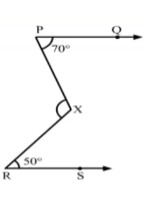In Figure, PQRS is a rhombus in which the diagonal PR is produced to T. If ∠SRT=1520, find x, y and z
To solve the problem, we need to find the values of x, y, and z in the rhombus PQRS where the diagonal PR is extended to point T and the angle ∠SRT=152∘.
1. Identify the properties of the rhombus:
In a rhombus, the diagonals bisect each other at right angles. Therefore, the diagonals intersect at 90∘.
Hint: Remember that the diagonals of a rhombus are perpendicular to each other.
2. Label the angles:
Let ∠SRT=152∘ and denote the angle at the intersection of the diagonals as y. Since the diagonals intersect at right angles, we have:
y=90∘
Hint: Use the property of diagonals intersecting at right angles to find one of the angles.
3. Use the exterior angle theorem:
The exterior angle ∠SRT can be expressed as the sum of the two opposite interior angles:
∠SRT=y+∠SRQ
Substituting the known values:
152∘=90∘+∠SRQ
Solving for ∠SRQ:
∠SRQ=152∘−90∘=62∘
Hint: Recall that an exterior angle is equal to the sum of the two opposite interior angles.
4. Identify parallel lines:
Since SR is parallel to PQ, we can say:
∠QSR=x=∠SRQ=62∘
Hint: Use the property of alternate interior angles when two lines are parallel.
5. Analyze triangle SPR:
In triangle SPR, we know:
- SP=SR (sides of the rhombus are equal)
- ∠SPR=∠SRP=z
Using the triangle sum property:
∠SPR+∠SRP+∠RSP=180∘
We substitute ∠RSP=y=90∘:
z+z+90∘=180∘
Simplifying gives:
2z=180∘−90∘=90∘
Thus:
z=45∘
Hint: Remember that the sum of angles in a triangle is always 180∘.
6. Final values:
We have determined:
- x=62∘
- y=90∘
- z=45∘
Summary of Results:
- x=62∘
- y=90∘
- z=45∘
In a rhombus, the diagonals bisect each other at right angles. Therefore, the diagonals intersect at 90∘.
Let ∠SRT=152∘ and denote the angle at the intersection of the diagonals as y. Since the diagonals intersect at right angles, we have:
y=90∘
The exterior angle ∠SRT can be expressed as the sum of the two opposite interior angles:
∠SRT=y+∠SRQ
Substituting the known values:
152∘=90∘+∠SRQ
Solving for ∠SRQ:
∠SRQ=152∘−90∘=62∘
Since SR is parallel to PQ, we can say:
∠QSR=x=∠SRQ=62∘
In triangle SPR, we know:
- SP=SR (sides of the rhombus are equal)
- ∠SPR=∠SRP=z
∠SPR+∠SRP+∠RSP=180∘
We substitute ∠RSP=y=90∘:
z+z+90∘=180∘
Simplifying gives:
2z=180∘−90∘=90∘
Thus:
z=45∘
We have determined:
- x=62∘
- y=90∘
- z=45∘
- x=62∘
- y=90∘
- z=45∘
Topper's Solved these Questions
Similar Questions
In Figure, PQRS is a square. Determine ∠SRP.
View SolutionIn Figure, PQRS is an isosceles trapezium. Find x and y
View SolutionIn Figure, OP∣∣RS. Determine ∠PQR
View SolutionIn Figure, PQRS is a square and SRT is an equilateral triangle. Prove that PT=QT (ii) ∠TQR=150
View SolutionIn figure, PQ=PR . Show that PS>PQ.
View SolutionIn Figure, two straight lines PQ and RS intersect each other at O. If ∠POT=750, find the values of a,b and c
View SolutionIn Figure , find out ∠PXR, if PQ ∣∣ RS.

View SolutionIn Figure, side QP and RQ of PQR are produced to point S and T respectively. If ∠SPR=1350and ∠PQT=110∘, find ∠PRQ
View SolutionIn figure, sides QP and RQ of PQR are produced to point S and T respectively. If ∠SPR=1350 and ∠PQT=1100, find ∠PRQ. Figure
View SolutionIn figure, sides QP and RQ of PQR are produced to point S and T respectively. If ∠SPR=1350 and ∠PQT=1100, find ∠PRQ. Figure
View Solution
